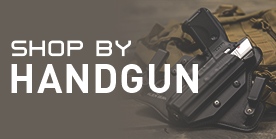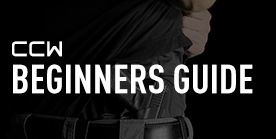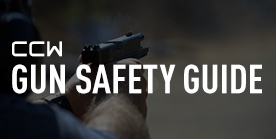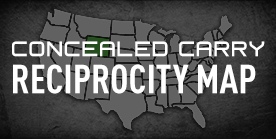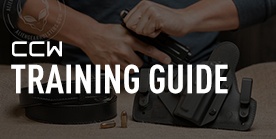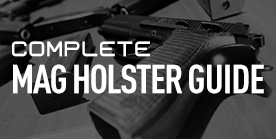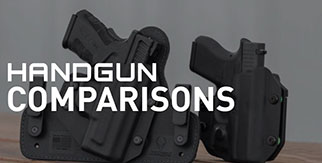How Are ShapeShift Shells Different From Kydex? [updated 2022]
How ShapeShift Holsters Are Different From Kydex
How is the ShapeShift holster shell different from Kydex? The latter material is something of an obsession in the carry community; some people insist that no other material shall ever carry their pistol.
So how does the ShapeShift set itself apart?
ShapeShift Holster Shell Is Injection Molded

A principle difference in the ShapeShift holster shell is how we make it compared to how kydex holster makers manufacture their product.
The ShapeShift shell is injection molded. Kydex, however, is press-molded. The reason why there are so many Kydex holster makers is the relative ease in getting started. This isn't to say that anyone can do it - though practically anyone actually can - and there are some quality producers out there with fastidious attention to detail.
How it works is that a sheet of Kydex - a hard plastic - is heated, then inserted into a mold press. The material has been heated to the point where it begins to flow (meaning it can be shaped) so it takes the shape of the mold when pressure is applied. As it cools, it hardens and retains the shape of the object it's molded on.
Excess material is trimmed away, the remaining material usually gets polished and presto! You have a holster shell.
The ShapeShift holster shell, however, is injection molded. Molten polymer is poured into an ultra-precise mold, and any air removed via industrial vacuum. After the material cools, product is ready to assemble, with no need for polishing or trimming away any excess. This ensures that you get a holster shell, precision-molded far beyond your standard kydex, to fit any open carry or concealed carry setup.
Again, this isn't to say that kydex holster makers make an inferior product. (Well…) ShapeShift Holster System products take a long time to develop due to the need for precise molds, which take time to perfect. "Good enough" is not acceptable at Alien Gear Holsters; it needs to be perfect or else we won't put it out there.
It's more that our injection molding creates a much more precise product.
ShapeShift Holster Material Vs Kydex

The material of the shell itself makes a big difference.
Kydex itself is an acrylic thermoplastic. What that means is it's chemically based on acrylic acid and becomes soft and moldable when some heat is applied to it and hardens when it cools…like most plastics.
The exact formula and name were devised in the 1960s by Rohm and Haas, a chemical company that was absorbed into Dow Chemical. The formula was sold to the appropriately-named Kydex LLC, which was later bought by Sekisui SPI.
In other words, it's a brand-name material sort of like brand-name Styrofoam from DuPont.
So…what's so special about it?
It has a Rockwell R (hardness rating system for plastics) of 90 to 95, depending on the exact formulation of Kydex you get. Typically it has a tensile strength of 6,100 psi and a flexular modulus (resistance to deformation) of 335,000 psi.
When it comes to resistance to deformation under pressure at temperature, it can deflect heat up to 173 degrees F at 264 psi of pressure on the material.
We can't tell you exactly what polymers we use or in what proportion. What we can tell you is that it's based on - but isn't exclusively - nylon. And no, before you start speculating, it isn't glass-filled or anything else; it actually is a custom blend of polymers.
Nylon polymer - not nylon cloth or thread - has a Rockwell R hardness of 100 to 120, depending on the exact formulation. Cast nylon has a flexular modulus of 500,000 psi or better, and a tensile strength of 13,000 psi or better, and a temperature deflection of 170 to 399 degrees F at 264 psi.
Okay, so what does that mean?
Nylon is harder than Kydex. It's stronger. It's more resistant to heat. In other words, nylon polymers are generally hardier and more durable than Kydex or Boltaron, a common alternative to Kydex.
This begs the question of why the industry and so many people have such a hangup about Kydex. The truth is that it's because it's what the public is used to seeing…but why are they? The quick answer is that Kydex is very easy to mold and work with, and the tooling required is very cheap.
The founder of Alien Gear Holsters started molding holster shells on his kitchen table; that's how simple it can be. You can literally make holsters with a primitive mold, a few sheets of Kydex and a toaster oven if you wanted to. You can't do that with nylon as it typically has to be injection molded; that requires a lot more tooling to even get started. It's neither cheap nor easy!
In other words, Kydex is a better material than some…but is inferior to others like injection-molded nylon-based polymers. And that's why we use it instead of Kydex.
Greater Precision And Durability: The ShapeShift Difference

What sets the ShapeShift holster shell - and indeed the ShapeShift Modular Holster System - apart is the greater degree of precision that's required of the molding process, as well as a much more durable material that's used to create the holster.
This gives you a holster shell for your concealed carry holster that fits perfectly. Notice the click that seems so satisfying when the gun fully seats in the holster? That's due to the fitment. Some people find they don't even need the passive retention to get a satisfactory hold when carrying. You get the perfect fit and a secure carry.
You also get a holster shell that you can depend on to last through years of service.
Add to that a 30 Day Test Drive trial period, lifetime warranty and the unparalleled versatility of the full ShapeShift system...and that's a significant difference from most other holsters out there.



